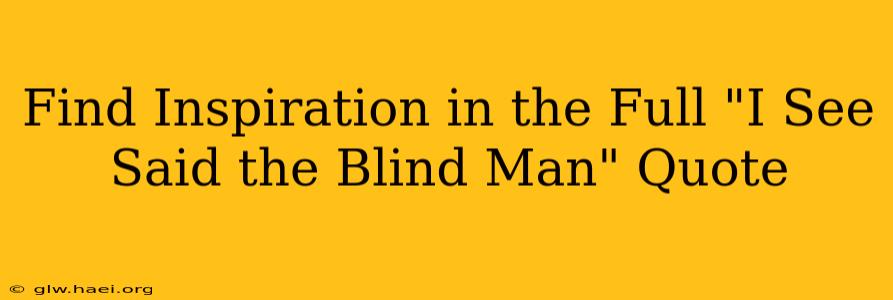The evocative phrase, "I see," said the blind man, often floats around as a standalone snippet, sparking curiosity and contemplation. But its power truly unfolds within the context of the full quote, revealing a deeper well of inspiration that transcends literal sight. Let's dive into this enigmatic statement and uncover the layers of meaning it holds.
Many variations of the quote exist, but the core message remains consistent. The full quote, often attributed to various sources, typically reads something like: "I see," said the blind man, "but with a different kind of sight." This simple sentence acts as a powerful metaphor for how we perceive the world, challenging our assumptions about limitations and the nature of perception itself.
What Does "I See" Really Mean?
This seemingly simple phrase is a profound declaration of inner vision. It challenges the superficial definition of sight, suggesting that the ability to "see" goes far beyond the physical act of using one's eyes. It speaks to the power of intuition, understanding, and insight—qualities that can be developed and honed regardless of physical limitations.
The blind man's statement isn't about denying his blindness; instead, it's about embracing a different way of seeing. It's about recognizing that our experiences, our understanding, and our emotional landscape shape how we perceive reality.
How Can We Develop a "Different Kind of Sight"?
The blind man’s words inspire us to cultivate alternative perspectives, to hone our inner vision. This involves several crucial aspects:
1. Embracing Intuition and Inner Knowing:
Often, our most insightful moments arise not from logic alone, but from a deeper intuitive understanding. Paying attention to those gut feelings, those hunches, and that inner voice can lead us to profound discoveries and solutions. The blind man's "sight" suggests trusting our inner wisdom.
2. Cultivating Empathy and Understanding:
True "sight" requires understanding perspectives different from our own. By actively listening to others, seeking to understand their experiences, and stepping outside our own biases, we expand our ability to perceive and comprehend the world's complexities. This empathy fosters connection and a richer understanding of the human experience.
3. Listening More Than We Speak:
A hallmark of truly "seeing" is the ability to listen deeply. By silencing our internal monologue and actively listening to what others say and what they don't say, we gain a more complete picture of a situation. Active listening expands our capacity for empathy and improves our understanding of nuanced communication.
4. Recognizing the Subjective Nature of Reality:
We each perceive the world through our unique lens, shaped by our experiences, beliefs, and biases. Recognizing this subjectivity allows for greater tolerance, understanding, and acceptance of different viewpoints. The blind man’s statement reminds us that there’s more than one way to "see."
Why is This Quote So Inspiring?
The quote's power lies in its universality. It speaks to everyone, regardless of their physical abilities or background. It reminds us that:
- Limitations can be overcome: The blind man's "sight" shows us that limitations are often self-imposed or perceived. With different approaches, we can overcome perceived barriers.
- Inner strength is powerful: The quote celebrates inner strength, intuition, and the ability to find new paths to understanding.
- Perspective is key: The quote emphasizes the importance of embracing different perspectives and the transformative power of empathy.
The "I see," said the blind man quote is a powerful reminder that true vision transcends physical limitations. It’s an invitation to cultivate our inner sight, to embrace empathy, and to recognize the richness of diverse perspectives. It inspires us to look beyond the surface and discover the deeper truths that lie within ourselves and the world around us.

